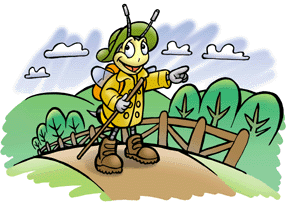
|
|
Teachers Henry Hikes to Fitchburg is a book that lends itself to many possible activities for students of all ages. The older the student the more in depth the teacher may want the student to study with regard to the life and times of Henry David Thoreau. This Website offers a variety of activities which may be expanded to involve students in guided or independent learning that allows for integrating literature, science, language arts, social studies, art, music, and mathematics. Students may produce a PowerPoint presentation on the book and what they have learned as Henry the Hiker, or the friend and his experiences. Directions for creating a PowerPoint slide show are included. In order to read and print the pdf files you will need Adobe Acrobat Reader. The images may look distorted in Adobe Acrobat Reader, but when printed they are very clear.
Students may use Microsoft Word to write poetry, descriptions, and information with borders and other stylized features. They can also insert photos, illustrations and graphics. Directions for creating documents are included.
Journals may be written in scrapbooks created by students. The writing may be done in word processing, printed and then cut and pasted in the books. This would allow for individual styles of fonts and custom design of the journal. Leaf pressing and nature sketches might be included in the student journal/scrapbook. See the scrapbooking sites for details and ideas on scrapbooking.
The treasure hunt will reveal many interesting tidbits about the book.
Using an 1852 Map of Concord, have students find locations.
Using information from articles about the Fitchburg Railroad, challenge your students with a few math problems.
Use the book as tie-in to problem-solving. Here is a unit designed by a math teacher in Kentucky. You will need Acrobat Reader.
Henry David Thoreau lived in Concord with great writers and thinkers during the transcendentalist era of the mid 1800s. Although younger students may not be ready for much of the original reading, they can relate to the philosophies of marching to a different drummer (Thoreau) living off the land and not needing so many material things that we miss the beauty of nature (Thoreau and Walden Pond), learning by being actively involved (Alcott), and self reliance (Emerson). The book, Henry Hikes to Fitchburg, is enjoyable at any level. However, once one realizes that Thoreau's philosophy has been beautifully illustrated in a picture book it is even more appreciated. Thoreau liked to juxtapose things and the book does just that on each page with Henry on one side and his friend on the other. If one knows that Thoreau loved to hike, press leaves in a music book that he carried with him, travel with a knapsack to collect things, used a walking stick notched to measure, and played a flute, then one can appreciate how the author/illustrator conveys this in twenty-eight illustrated pages. Allow students the delight in examining each illustration. Let them discover Henry David Thoreau by searching each picture for clues to Thoreau's interests. Then complete the Web activity on Henry Hikes to Fitchburg and see how the author portrayed Henry David Thoreau's life and times in this book. Read how we introduced the Take a Hike with Henry Activity.
|
||||||||||||||||||||||
|
|||||||||||||||||||||||
© 1996 - 2011 Linda C. Joseph
All Rights Reserved
All CyberBee Graphics are Trademarked
Graphics by
Darlene Vanasco/Creative Director
Erika Taguchi/Designer & Illustrator
Hosting Provided by Iwaynet
